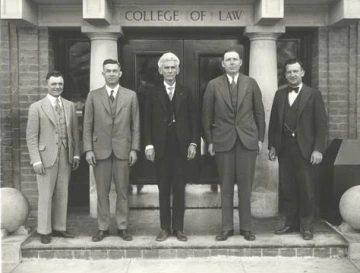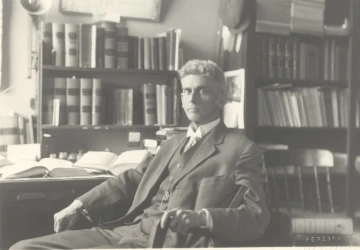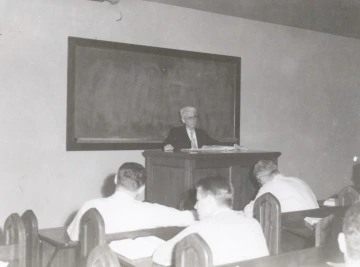
Dean Fegtly (center) and Dean J. Byron McCormick (to the right of Fegtly) with other law faculty in front of Douglass Hall (date unknown).
James E. Rogers College of Law
DEAN SAMUEL MARKS FEGTLY: 1925–1938
Before Arizona Law
Samuel Marks Fegtly was born on August 30, 1867, to Jacob and Mary Fegtly in the city of Nevada, Iowa. Fegtly graduated from Nevada High School in 1884, after which he attended Simpson College, also in Iowa, from 1885 to 1887.[1] Several years later, Fegtly continued his education in Chicago at Northwestern University, graduating first with a B.A. in Philosophy in 1897 and then graduating again with an LL.B. in 1900. He served as a collegiate cheerleader throughout his time at Northwestern, exhibiting an enthusiasm for sports and athletics that he retained throughout his life.[2] Along with his career, Fegtly found love in Chicago, marrying his wife, Mary Alice Archer Fegtly, in 1903.
After graduating, Fegtly began working as a lawyer in the Chicago area, establishing “himself as one of the ablest lawyers in the east.”[3] He represented the state Bank of Chicago (a private bank operating under an Illinois charter) from 1901 until 1912, afterwards striking out on his own in private practice.[4] In 1915, Fegtly and his family decided to escape the Illinois cold and move to Arizona. The day before their move, the University of Arizona asked Fegtly to move to Tucson and serve as a law professor in its newly created Department of Law. Fegtly, who had actively been looking for an academic position, accepted the offer and thus became one of the University’s first legal faculty.[5]
Early Years at Arizona Law
Although the University of Arizona began offering basic law classes as early as 1909,[6] it did not offer a formal law degree until the fall of 1915, when it created the Department of Law. Three professors, including Fegtly, were brought onboard to design and teach the legal curriculum.[7] As such, all three handled multiple classes: Fegtly was responsible for Agency, Evidence, Suretyship, Bills & Notes, Mining Law, and Torts.[8] Alongside their law classes, each professor also taught non-law classes. Fegtly, for his part, also taught public speaking.[9] As one might expect of a public-speaking professor, Fegtly spoke with a voice that carried far beyond the walls of his classroom—a Spanish professor who shared a classroom wall with Fegtly often complained that his “vociferous teaching spoiled her teaching.”[10] Fegtly’s first classroom was located in the University’s Old Main building, which did not have a central heating system. Thus, Fegtly would later fondly recount that his job required him to “stoke students with Blackstone while he stoked a stove with coal.”[11]

Professor Samuel M. Fegtly ushered the College of Law from a fledgling department in 1915, to a School of Law in 1918, and then to a College of Law in 1925. Fegtly was Dean of the College of Law from 1925-1938.
Special Collections, University of Arizona Libraries
As a teacher, Fegtly ran a tight ship. He strictly followed the Socratic method, cold-calling students randomly by using a stack of cards bearing their names. Whenever he finished going through the name cards, he would reshuffle the “deck” and start cold-calling through it again.[12] One of Fegtly’s first students, Harry C. Westover (who, along with his brother, was the law program’s first graduate and who later became a federal judge for the Southern District of California), remembered Fegtly as a professor who cared far more about the quality of his students’ reasoning than about whether they came to a particular conclusion. Westover recounted that, under Fegtly’s tutelage, no one “could have received better instruction in the study of law than my brother and I during the three years we were in law school.”[13]
In the fall of 1916, Fegtly became Head of the Department of Law after the other two faculty members resigned.[14] From this point until his retirement in 1938, Fegtly was in charge of the law program. This was not an easy charge. The Department’s early years were rocky for a number of reasons, including national skepticism about whether the state of Arizona needed its own law school[15] and a dearth of students caused by the national draft of young men during World War I.[16]
Throughout those initial years, Fegtly was the only faculty member who stayed with the Department; and under Fegtly’s leadership, the Department overcame many challenges. In 1919, the Department was upgraded to a “School of Law,” an organizational change necessitated by a flood of soldiers-turned-students following the close of World War I.[17] By 1922, the School received acceptance on a national level when the Department of the Interior’s Bureau of Education, after auditing the University, wrote that it was “impressed with the earnest spirit in the school of law and with the excellent training and experience of its faculty members.”[18]
Fegtly was a driving force behind 1925 statutory amendments through which the Arizona Legislature gave the law program a permanent status by encoding it as the University’s fifth official “College.” This change provided the program with levels of institutional, financial, and directional independence that it did not previously possess. The Arizona Wildcat, a student-run newspaper, praised Fegtly for this change, saying the “future of the College of Law is assured, and it is almost entirely due to the far-sightedness and administrative ability of Professor Fegtly.”[19] Upon creation of the College of Law, Fegtly was promptly appointed its first Dean.[20]
Tenure as Dean
During Fegtly’s tenure as dean, he guided the College through a number of many important milestones for the College. The first such milestone was moving the College into its own building in 1929. Up until this point, College had shared a building with several other departments. However, after a new building was built for the main library in 1928, Fegtly oversaw renovation of the old library building and secured it as the College’s first home. Fegtly was closely involved with this renovation, specifically designing the classrooms to resemble those of his alma mater, Northwestern, which in turn were modeled after the English Parliament.[21]
Because of increased space within the new building, the College’s law library started to expand, which in turn allowed the College to meet several national accreditation standards. By 1929, the library’s collection had grown from just over 4,000 volumes, in 1925,[22] to 7,500 volumes, which allowed the College of Law to become accredited by the American Bar Association.[23] By 1932, the collection had increased to 10,000 volumes, which allowed the College to become a member of the Association of American Law Schools.[24] Fegtly’s support for the library’s growth was critical during this time because University-wide budget cuts were shrinking the College’s budget[25]—however, Fegtly expanded the law library nevertheless.
Both before and after becoming dean, Fegtly was closely involved with the greater University, even in matters that did not pertain to the College of Law. For instance, he was a common participant on University committees throughout his time in Tucson.[26] Fegtly’s involvement with the University also extended past his duties as a faculty member; for instance, he founded and coached the University’s first intercollegiate debate team.[27] Additionally, Fegtly was an active member of many professional organizations. He was a member of the American Bar Association, the Arizona Bar Association, the American Academy of Social & Political Sciences, Phi Betta Kappa (the oldest academic honor society in the United States), Delta Sigma Rho (a public-speaking oriented honors society), Pi Gamma Nu (a business fraternity), and the Order of the Coif.[28]
Perhaps Fegtly’s most noteworthy accomplishment was earning the deep admiration of his students. Soon after the College moved into its new building in 1929, law students began a tradition of standing whenever Fegtly would enter a room.[29] Around the same time period, the student body commissioned a law student to paint a life-size portrait of Fegtly, which was promptly hung in the expanding law library.[30] These acts of respect were produced by Fegtly’s personality: he was a cheerful and quick-witted person, and he always dressed formally with the exception of a “tiny hat” that he was fond of wearing.[31] Fegtly also was quite fond of his students, an example being his creation of a tradition in 1932 called the “Dean’s Breakfast,” at which Fegtly would personally book out a local restaurant and host a breakfast for the graduating law students on the morning of their graduation.[32]
Fegtly was a firm believer in the value of practical legal education.[33] Reflecting this, during Fegtly’s deanship the College’s core curriculum included a “Practice Court” that all 3Ls were required to participate in. This Practice Court, similar to a mock-trial program, enabled “the Law School not only to emphasize in the student's mind this practical relation between his theoretical study and the practice of law; it [enabled] the Law School also to emphasize the cumulative nature of the student s work.”[34] One lasting tribute to Fegtly’s belief in practical education is Fegtly Moot Court, an annual competition created in 1938 in honor of Fegtly’s retirement.

Dean Fegtly teaching class in the Douglass Building (year unknown).
Retirement and Beyond
After spending 22 years as the Head, Director, and Dean of the law program, Fegtly retired in 1938. The University, recognizing Fegtly’s pivotal contributions to legal education in Arizona, published the following statement within its annual report to the Arizona Board of Regents:
"The close of the academic year 1937-38 marked the retirement from administrative duties of one of the University's most distinguished officers. Samuel Marks Fegtly, Ph.B., LL.B., Dean of the College of Law since its inception, reached the University retirement age on July 1, 1938, and became Dean Emeritus. The University will continue to benefit from his years of experience and mature judgment, since he remains a member of the law faculty. The University is greatly indebted to Dean Fegtly for the contribution he has made to the University and to the state in the cause of legal education.
The state of Arizona is justly proud of its pioneers in many fields. Dean Fegtly is the state's pioneer in the field of legal training for the bar. After graduation from Northwestern University School of Law and a most successful professional career in Chicago, he came to this state in 1915 to join the faculty of the University, just then inaugurating its first courses in law. In succession he was Head of the Department of Law in the College of Letters, Arts, and Sciences; then Director of the School of Law; and. after the establishment of the College of Law in 1925, he continued his service as its Dean until his recent retirement. The College developed under his administration to an institution of national repute."
. . .
There is a very select category of the bar known as the "philosophical lawyers," and Dean Fegtly ranks with those few members of his profession. He is a legal scholar of great ability. His knowledge of the common law and its development has made him a master of the law of torts, evidence, and future interests. Graduates of the College of Law, "my boys,” as he is wont to call them, are now practicing their profession in twenty-seven states and in the Philippines and foreign countries. Several have graced the bench of Arizona and many are in high places in the public affairs of this and other states. No greater tribute could be paid the Dean. The accomplishments and attainments of the graduates of his college speak more impressively than mere words.[35]
Upon his retirement, Fegtly was promptly elected to the position of “Dean Emeritus.” His career was honored at a testimonial dinner attended by most of his former students, a group that included many “prominent lawyers, Arizona Supreme Court Judges and Federal Court judges.”[36] Fegtly’s retirement did not signal his departure from the law school, however, and he continued to serve as a part-time law professor until shortly before his death in 1947. Fegtly was succeeded by James B. McCormick.
-- Daniel Bowman (’22)
[1] Samuel Marks Fegtly (1867–1947), Nev. Evening J. (Aug. 16, 1947), http://iagenweb.org/boards/story/obituaries/index.cgi?review=499492.&nb…;
[2] D. Benjamin Ferrarino & Lars Lagerman, The History of The University of Arizona College of Law 1909–1976 4, 28 (unpublished) (on file with Univ. of Ariz. Law Library, CRG Collection).
[3] Univ. of Ariz., Annual Report of the University of Arizona 75–76 (June 30, 1938); Best Legal Minds Procurable Are on Law Faculty Here, Ariz. Daily Wildcat, May 22, 1925, at 1.
[4] Samuel Marks Fegtly (1867–1947), supra note 1.
[5] Ferrarino & Lagerman, supra note 2, at 4–5.
[6] See The Univ. of Ariz., Minutes of Meetings of the University of Arizona Faculty Vol. 1 412 (Sept. 27, 1909) (on file with University of Arizona Special Collections).
[7] The other two professors were Howard Milton Colvin, LL.B. (who designed the curriculum) and Sydney Joseph Franks, J.D. Univ. of Ariz., Annual Catalogue 1915–1916 10 (May 1916).
[8] The Univ. of Ariz., Annual Catalog: 1916–1917 119–22 (Mar. 1917), https://repository.arizona.edu/handle/10150/580384.
[9] Best Legal Minds Procurable Are on Law Faculty Here, Ariz. Wildcat, May 22, 1925, at 1.
[10] Ferrarino & Lagerman, supra note 2, at 5.
[11] Id.
[12] Ferrarino & Lagerman, supra note 2, at 29.
[13] Doulas D. Martin, The Lamp in the Desert 112–13 (1960).
[14] Started Ten Years Ago as Department, Ariz. Daily Wildcat, May 22, 1925, at 1.
[15] SeeDep’t of the Interior Bureau of Educ., Report of a Survey of the University of Arizona 30–33 (1917).
[16] Samuel M. Fegtly, Some Random Thoughts on Legal Education in the University of Arizona in Univ. of Ariz., Annual Report 74 (June 30, 1938).
[17] Id. See also, University of Arizona, 1919-1920 Annual Catalogue, at 148, for the first instance of School of Law rather than Department of Law, as named in the 1918-1919 Annual Catalogue, at 135.
[18] Dep’t of the Interior Bureau of Educ., Report of a Survey of the University of Arizona 13 (1922).
[19] Best Legal Minds Procurable Are on Law Faculty Here, Ariz. Daily Wildcat, May 22, 1925, at 1.
[20] See Univ. of Ariz., Record of Faculty Meetings (Apr. 16, 1925) (unpublished) (on file with Univ. of Ariz. Special Collections).
[21] Ferrarino & Lagerman, supra note 2, at 20.
[22] Law Library Here Large and Select, Ariz. Daily Wildcat, May 22, 1925, at 1.
[23] John D. Lyons, The First Fifty Years of the College of Law, 7 Ariz. L. Rev. 173, 176 (1966).
[24] Martin, supra note 12, at 147.
[25] See id. at 146–48.
[26] See generally The Univ. of Ariz., Minutes of Meetings of the University of Arizona Faculty Vol. 1, supra note 6.
[27] Ferrarino & Lagerman, supra note 2, at 6.
[28] Id.
[29] Ferrarino & Lagerman, supra note 2, at 32.
[30] Id. at 29
[31] Id.
[32] Id. at 144.
[33] See generally Samuel M. Fegtly, Some Random Thoughts on Legal Education in the University of Arizonain Univ. of Ariz., Annual Report of the University of Arizona 73–91 (June 30, 1938).
[34] Id. at 86.
[35] Univ. of Ariz., Annual Report of the University of Arizona 9 (June 30, 1938).
[36] Ferrarino & Lagerman, supra note 2, at 30.

